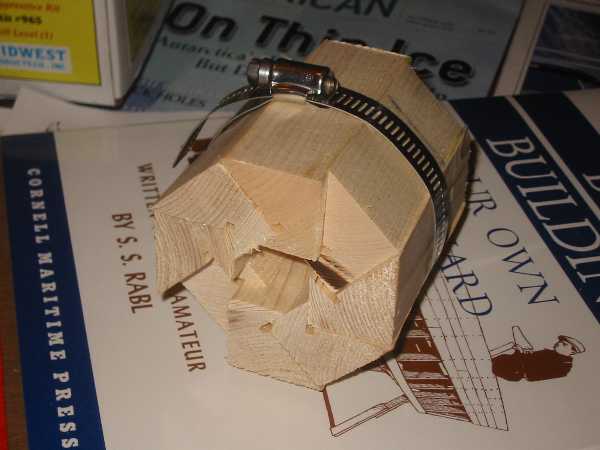
A prototype for a birdsmouth mast. This is an experimental mast to be built in addition to the solid wood masts specified in the plans.
Today has been full of non-progress in mast construction. The planks I brought inside before proved to be warped beyond all belief. Also I found some checking of a disturbing nature. My original plan was to glue these two pieces together and make it round.
I tried to deal with the warpage by ripping the wood into 1/4 inch strips which I would then stack and glue. I got out the tablesaw and proceeded to rip. The warpage would push the wood away from the rip fence resulting in uneven thicknesses. The motor started smelling bad and smoking.
I constructed a prototype of the birdsmouth method shown above. The Birdsmouth is discussed in detail in Woodenboat magazine number 149 pp 31.
But before I could proceed any further, the tablesaw motor completely burned up. I then hung it up for the day and pondered my next actions.I could build the birdsmouth. This has these advantages.
- Easy ripping that doesn't overly stress the dainty tablesaw I have.
- Can be quickly glued and clamped using hose clamps.
- Results in an 8 sided shape that can quickly be rounded.
- The knots in the wood can be easily distributed so their effect on the strength is negligable. Larger knots can be cut out and the wood scarfed around them.
- The size of the hole can be easily controlled to make it small and approach what is specified in the plans.
- The mast is lighter and nearly as strong as a solid mast. In fact the strength to weight ratio is higher than a solid mast.
- The hole would allow the passage of wires and antennae but in practice it is best to put solid wood at the ends and at the mast partners.
The second course of action is simpler and closer to the plans. It consists of gluing together a pair of two by sixes, then cutting to size and rounding.
The third course of action is to order solid, clear spruce from an out-of-town supplier and have it shipped here. This gets rather expensive.
I decided to do the second option. Later I may build a birdsmouth mast to experiment with.